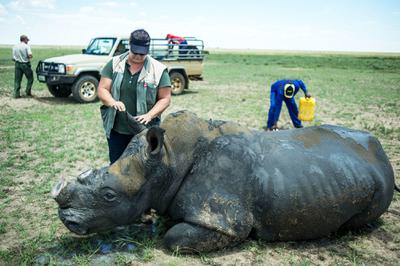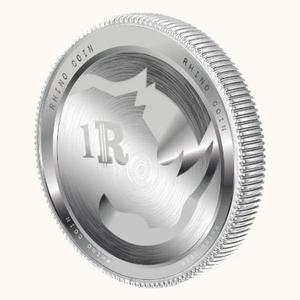“We desperately require a revenue stream to pay for the conservation of these animals,” says a spokesman for rhino ranchers.
“Private reserves have spent well over 2 billion Rand (about $140 million) from 2009 to the end of 2017 in protecting their animals,” says Pelham Jones, chairperson of the Private Rhino Owners Association. “We desperately require a revenue stream to pay for the conservation of these animals, especially when you put it in the context that we now own about 50 percent of the national herd.”
Rhino Coin lies at the bleeding edge of a debate that has raged for years about legalizing trade in rhino horn, a debate sharpened by ongoing, intense poaching. The international sale of rhino horn has been banned under the Convention on International Trade in Endangered Species (CITES) since 1977, and the domestic trade within most Asian countries, including the major markets of China and Vietnam, has also long been illegal.
The majority of global conservation and animal welfare organizations are dead-set against legalizing trade, believing that it could drastically worsen poaching by generating uncontrollable consumer demand for horn. Conservationists say that the pool of potential Chinese buyers is so large that they would consume legal stocks faster than they could ever be replenished, incentivizing poachers to make up the shortfall. And experts argue that because poached horn products are difficult to distinguish from horn products legally harvested and traded within South Africa, a legal international trade could create conduits for poached horn to find its way to market.
A veterinarian examines a recently-dehorned rhino on John Hume's ranch near Klerksdorp, South Africa. Hume owns more than 1,600 rhinos, which are dehorned to dissuade poachers. MUJAHID SAFODIEN/AFP/Getty Images
South Africa — unusual among African countries — has a large private wildlife ranching sector. Ranching is a loose term: Some ranchers operate what can only be described as rhino feedlots, where they confine dozens of rhinos to a single corral and give them factory-made feed every day. John Hume, the world’s largest rhino owner with a herd of more than 1,600 animals, keeps many of his animals this way. Hume has heavily backed the Rhino Coin initiative and is the leading contributor of horn to the system.
Other ranchers keep rhinos that are effectively wild, ranging over huge areas and feeding themselves. Almost all rhino ranches need security forces to ward off poachers, who wield increasingly powerful guns and even improvised explosive devices. Deadly firefights are common. Public and private reserves deploy rangers with automatic rifles and grenade launchers, miles of deadly electric fencing, light aircraft and helicopters, as well as military-grade radar, cameras, and listening tools. This has reduced poaching in some reserves. It’s also extremely expensive, hence efforts to raise funds through selling rhino horn.
South Africa placed a moratorium on the in-country trade of rhino horn in 2009 because government agencies found it being used as cover to sell poached horn to international crime syndicates. Despite opposition from conservation groups, well-resourced South African private rhino owners pushed for re-legalizing trade, and last year they won a case in the South African Constitutional Court and overturned the 2009 moratorium.
The government has now constructed somewhat cumbersome systems that can support in-country trade, such as a DNA horn registry, a national database, and a system of permits whereby registered buyers and sellers can legally trade horn within South Africa while the state keeps tabs on the ownership of each one. (Some 860 horns have been traded domestically this year, according to the Department of Environmental Affairs.)
It’s become common for reserves and ranches to de-horn rhinos to lessen the animals’ value to poachers.
Rhino Coin was launched earlier this year to simplify the process of legally trading horn and to create a revenue stream for rhino owners and rhino conservation in general. “Our concept was that it would be like the gold standard,” says Wilcocks. But his plan uses cryptocurrency traded on the Internet instead of paper dollars, and rhino horn instead of gold. Most Rhino Coin buyers are speculators, betting that the international rhino horn trade ban will one day fall away, and that horn can then be sold at a stupendous markup in Asia.
Under the Rhino Coin scheme, a horn owner places horn into the Rhino Coin system by legally selling it to Cornu Logistics. The horn is weighed to the nearest gram, audited, and placed in Cornu’s vault. One digital token — a Rhino Coin — is created for each gram of horn via blockchain technology, a means of creating a distributed database of records that are verifiable and resistant to corruption. Rhino Coins can be bought with South African Rands by domestic and international buyers and traded on the Cornuex exchange, where their price fluctuates according to supply and demand.
The horn owner is given 54 percent of the Rhino Coins and can retain those tokens or sell them on the exchange for cash at any point. The rest of the coins are allocated to a conservation foundation, a children’s home, and administrative costs, such as horn storage.
Wilcocks says that all the coins generated from the 108 kilograms of horn in Cornu’s vault are in circulation, but that trade volumes have been low because they’ve not been doing any promotion recently. No coins have been redeemed for horn yet. He says he plans to launch a publicity campaign in January to increase interest in Rhino Coin, and an additional 500 kilograms of horns are waiting to be audited to add to the system.
It’s become common for reserves and ranches to de-horn rhinos to lessen the animals’ value to poachers and allow horns to be harvested. Rhinos are typically tranquilized with a dart gun by a veterinarian and their horns painlessly cut off with a small chainsaw a couple of inches above the base. This can be repeated every two or three years as the horns regrow. Jones of the rhino owners’ association estimates that roughly 30 tons of horn are now stockpiled in South Africa — about 10 tons collectively owned by the private sector, and 17 to 20 tons sourced from national parks and other state-owned reserves and held in government vaults.
Jones says that horn from this stockpile, continually replenished from rhino farms, could generate a colossal 65 billion Rand (about $4.5 billion) over five years if legally sold in Asia. (More conservative estimates place the potential value of South Africa’s stockpile at more than $1 billion.)
Rhino horns being weighed and stored at John Hume's ranch in February 2016. Hume is the leading contributor of horn to the Rhino Coin system. MUJAHID SAFODIEN/AFP/Getty Images
Many rhino custodians — including certain government conservation agencies and the majority of private rhino owners in southern Africa — feel strongly that legal trade can further incentivize rhino conservation, and that Asian markets can be managed so that uncontrollable consumer demand doesn’t lead to runaway poaching.
But conservation organizations often cite a 2008 legal sale of elephant ivory from Botswana, South Africa, and Zimbabwe to China and Japan as a reason not to sell rhino horn. Like rhino horn, the international trade in ivory had long been forbidden, but in 2008 CITES allowed a strictly regulated “one-off sale.” Even though China rolled out sophisticated safeguards to monitor and control ivory from this sale, these failed, says Colman O Criodain, policy manager of wildlife practice for WWF International. Numerous unaccredited stores and ivory-carving workshops sprung up to take advantage of revived consumer demand, and “there was a parallel illegal market that they were either unwilling or unable to control.”
Elephant poaching and ivory trafficking skyrocketed to supply these illegal outlets; by 2011, at least 15,000 African elephants were being killed annually. Following international pressure, China has cracked down on illegal trade and banned the domestic sale of ivory; elephant poaching rates have since dropped.
Although Hume portrays himself as a rhino-loving conservationist, his motives have often been questioned. He owns tons of horn, and might make hundreds of millions of dollars if he gets to sell it in Asia. He has in the past sold rhinos to be shot by trophy hunters and also has sold the animals to two brothers, who are suspected rhino poachers and horn traffickers, according to the Organized Crime and Corruption Reporting Project.
Rhino coin is “not really mainstream conservation in any sense of the word,” says one expert.
Some observers say that since buyers can purchase tokens from anywhere, CITES might view Rhino Coin as a form of international horn trade and try to constrain it; after all, the treaty’s text regulates wild species “and their derivatives.” Tom Milliken of TRAFFIC, the wildlife trade research organization, says “I don’t have a lot to say about Rhino Coin other than it is an attempt to get funding to support a private rhino farmer who is quite a controversial figure, but it’s not really mainstream conservation in any sense of the word. It will probably not demonstrate any traction in financial markets as time goes by.”
WWF’s O Criodain says he would not bet on the trade in rhino horn being legalized internationally or within China because of powerful global resistance. Rhino Coin speculators may never realize a profit, he says. He points out that on October 30 the Chinese government announced that it would be lifting the ban on rhino horn use in Traditional Chinese Medicine (TCM), a possible first step to open trade. But it soon backed down under a storm of protest from conservation organizations, announcing on November 12 that “the detailed regulations for implementation” of the October legal change had been “postponed after study” and that the strict ban on sale and use of rhino horn remained in effect. It’s not clear whether regulations to allow TCM use will ever be written.
Although rhino deaths appear to be declining slightly in South Africa this year due to better anti-poaching measures, recorded incursions into reserves and attempts to poach continue to rise because transnational criminal syndicates are still buying horn. Meanwhile, private and government stockpiles continue to grow, further increasing the incentives to sell.






